Grade 5 division worksheets: Free & printable
Are you ready to become a division master? Do you want to learn how to solve any division problem quickly and confidently? Do you want to have fun while practicing your skills and preparing for your grade 5 division test? If you answered yes to these questions, this article is for you! Here, you’ll find an excellent collection of Free & printable Grade 5 division worksheets for
-
How to master Grade 5 division in no time: the smart way with engaging Grade 5 division worksheets
Available in this article are smart ways with engaging Grade 5 division worksheets and ideas on how to master Grade 5 division in no time. Mastering division skills is vital to students' academic success. These skills go beyond math to real-life problem solving; hence vital for 5th graders to grasp at their fingertips.
However, to help your 5th-grade students enhance their division skills, you can download and print free Grade 5 division worksheets from Mathskills4kids, perfect for at-home learning or classroom practice.
Also, these division worksheets will offer 5th graders the practice they need for dividing small to larger digit numbers, estimating quotients, dividing by 10, 100, etc.
Below is a guide to everything this article has prepared for us. So, stay focused and discover:
- The importance of division in grade 5 and why it is a key skill for your future success
- Why division is fun and easy: a quick review of the basics and how to apply them
- How to divide like a pro: tips and tricks for solving any problem, from simple to complex
- The power of practice: how engaging worksheets can boost your skills and confidence and make you enjoy learning
- How to ace your grade 5 division test: a step-by-step guide to prepare for the big day and impress your teacher and classmates
- How to help your child with division: a parent's guide to supporting learning at home and making it fun and rewarding
- Bonus: the best resources for grade 5 division and where to find them (descriptions and pages' addresses if available)
Ready? Let's dive in!
-
BROWSE THE WEBSITE
-
DOWNLOAD FREE WORKSHEETS
-
-
5th GRADE MATH TOPICS
- Number sense
- Addition and subtraction
- Multiplication
- Division
- Exponents
- Number theory
- Decimals
- Add & subtract decimals
- Multiply decimals
- Divide decimals
- Fractions & mixed numbers
- Add & subtract fractions
- Multiply fractions
- Divide fractions
- Mixed operations
- Problems solving
- Ratios and rates
- Percentages
- Money Math
- Number sequences
- Coordinate graph
- Variable expressions
- Data and Graphs
- Probability and statistics
- Telling time
- Unit of measurements
- 2D figures
- Triangles & quadrilaterals
- Symmetry & transformations
- 3D figures
- Geometric measurements
-
-
Division facts up to 12 -
Division facts to 12 practice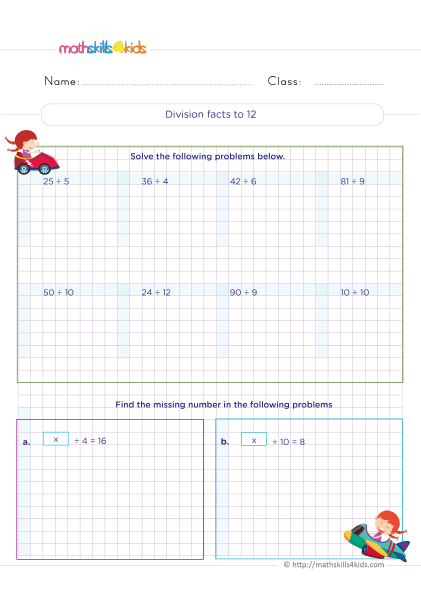 Print it...
Print it...
-
Dividing multi-digit numbers by 1-digit numbers word problems
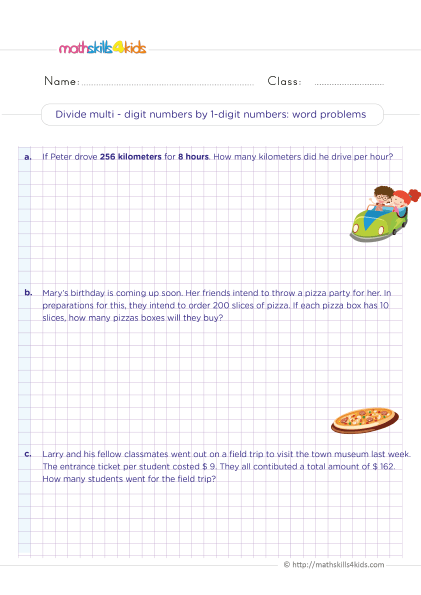 Print it...
Print it...
-
Solving division patterns over increasing place values
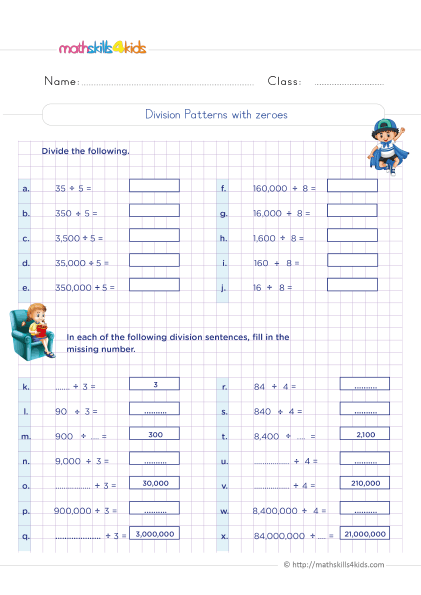 Print it...
Print it...
-
Estimating quotients word problems -
How to estimate quotient?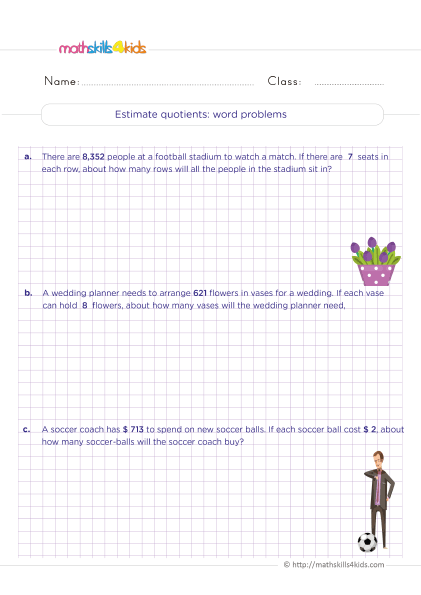 Print it...
Print it...
-
Dividing 4-digit by 2-digit numbers word problems
 Print it...
Print it...
-
Choose numbers with a particular quotient: complete the division sentence
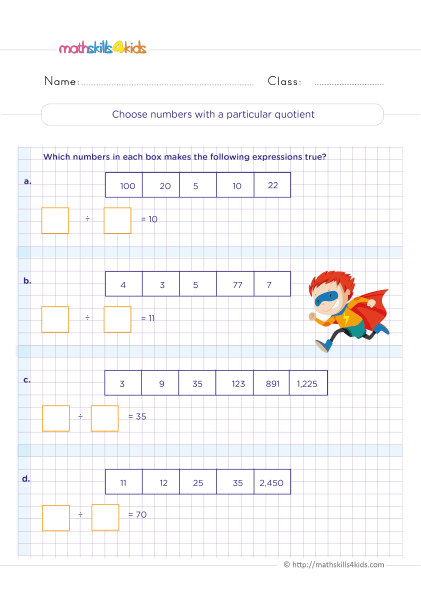 Print it...
Print it...
-
Division facts up to 12 -
-
Buying is supporting us!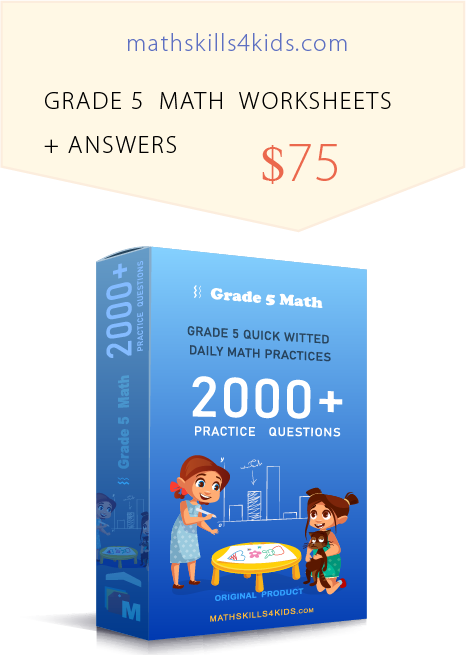
Buy Now...
-
-
The importance of division in Grade 5
Division is one of the four basic operations in math, along with addition, subtraction, and multiplication. It is the process of splitting a number into equal parts or groups. For example, if you have 12 cookies and want to share them with 3 friends, you can divide 12 by 3 to determine how many cookies each person gets. The answer is 4 cookies per person.
Division is important because it helps us understand how things are distributed or arranged in the real world. For example, we can use division to:
- Find out how many people can fit in a car, a bus, or a plane
- Calculate how much money we need to pay for something or how much change we get back
- Measure how long it takes to do something or how fast something is moving
- Compare the sizes or quantities of different things
- Simplify fractions or decimals
Also, division is important in grade 5 because it prepares 5th graders for more advanced math topics that they will learn in later grades, such as ratios, proportions, percentages, algebra, geometry, and more. Mastering division in grade 5 will give students a solid foundation for their future math success!
-
Why division is fun and easy: A quick review of the basics
Most people might think division is complicated or boring, but that's not true! Division is fun and easy once we understand the basics and how to apply them. Let's review some of the key concepts and terms that you need to know:
- A division problem has three parts: the dividend, the divisor, and the quotient. The dividend is the number being divided, the divisor is the number that divides the dividend, and the quotient is the answer. For example, in 12 ÷ 3 = 4, 12 is the dividend, 3 is the divisor, and 4 is the quotient.
- A division problem can also have a remainder, the part of the dividend left over after dividing. For example, in 13 ÷ 4 = 3 R1, 13 is the dividend, 4 is the divisor, 3 is the quotient, and 1 is the remainder.
- A division problem can be written in different ways: as a fraction (12/3), as a long division (12 ÷ 3), or as an inverse multiplication (12 = 3 x ?). All these ways mean the same thing: how many times does 3 go into 12?
- A division problem can be solved using different strategies: by using repeated subtraction (12 - 3 - 3 - 3 - 3 = 0), using skip counting (3, 6, 9, 12), using multiplication facts (3 x ? = 12), by using partial quotients (10 ÷ 3 = 3 + (2 ÷ 3)), or by using an algorithm (the standard long division method).
- A division problem can be checked using inverse operations: multiplying the quotient by the divisor and adding the remainder (if any) to get back the dividend. For example, to check if 13 ÷ 4 = 3 R1 is correct, we can do (3 x 4) + 1 = 13.
As you can see, division is easy and exciting after all! It's just a matter of knowing what to do and how to do it. And once you master these basics, you can move on to more challenging problems that involve larger numbers, decimals, fractions, and more!
-
How to divide like a pro: Tips and tricks for solving any problem
We've learned the basics of division, but now you want to take your 5th grader’s skills to the next level. How can they divide like pros? Mathskills4kids.com offers tips and tricks to help Grade 5 students solve any division problem quickly.
- Use mental math. Sometimes, we can divide numbers in our heads without writing anything down. For example, if we want to divide 36 by 4, we can think of it as 4 times 9 or 9 times 4. So, the answer is 9. Mental math is faster and more convenient than calculators or paper and pencil. It also helps to develop our number sense and estimation skills.
- Use shortcuts. Some tricks can help us divide faster and easier. For example, if we want to divide by 10, we can move the decimal point one place to the left. If we want to divide by 100, move the decimal point two places to the left. And so on.
- Use divisibility rules. These rules tell us if a number is divisible by another number without doing the actual division. For example, a number is divisible by 2 if it ends in an even digit (0, 2, 4, 6, or 8). A number is divisible by 5 if it ends in 0 or 5. A number is divisible by 10 if it ends in 0. And so on.
Using shortcuts can save time and effort when dividing large numbers.
- Use long division. Sometimes, we can use long division to divide numbers that are difficult to do mentally or with shortcuts. Long division is a method that breaks down a division problem into smaller steps.
We can use long division to divide any two numbers, big or small. To do long division, we must know how to divide, multiply, subtract, and bring down. Here are the steps for long division:
- Write the dividend (the number being divided) inside the long division symbol and the divisor (the number doing the dividing) outside.
- Divide the first digit of the dividend by the divisor. Write the quotient (the answer) above the long division symbol.
- Multiply the quotient by the divisor and write the product under the first digit of the dividend.
- Subtract the product from the first digit of the dividend and write the difference below.
- Bring down the next digit of the dividend and write it next to the difference.
- Repeat steps 2 to 5 until there are no more digits to bring down or until you get a remainder (a number left over after dividing).
- If there is a remainder, write it after a decimal point and continue dividing until you get a decimal answer or until you get a repeating pattern of digits.
Here is an example of long division:

In this example, we divided 54 by 12 using long division. We got a quotient of 4.5 and no remainder.
- Check your answer. After dividing, it’s important always to check our answer to ensure it is correct. One way to check our answer is to use the inverse operation of division, which is multiplication, and the estimation method:
- To check using the inverse operation of division, which is multiplication, multiply the quotient by the divisor and see if you get the dividend. If you do, your answer is correct. If not, your answer is wrong, and you will redo the problem. For example, to check our previous example, we can multiply 4.5 by 12 and see if we get 54.
4.5 x 12 = 54
Since we got the same dividend as before, our answer is correct.
- Using estimation. To estimate your answer, round up or down the numbers in the problem and divide them using mental math or shortcuts. Then compare the estimated answer with the actual answer and see if they are close enough. If they are, the answer is probably correct. If not, the answer is probably wrong, and we’ll redo the problem.
For example, to estimate our previous example, we can round up 54 to 60 and round down 12 to 10, then divide them using mental math.
60 ÷ 10 = 6
Our estimated answer is 6, close enough to our actual answer of 4.5. Our answer is correct.
- To check using the inverse operation of division, which is multiplication, multiply the quotient by the divisor and see if you get the dividend. If you do, your answer is correct. If not, your answer is wrong, and you will redo the problem. For example, to check our previous example, we can multiply 4.5 by 12 and see if we get 54.
These tips and tricks will help you divide like a pro in no time!
-
The power of practice: How engaging division worksheets can boost 5th graders' skills and confidence
You've learned some tips and tricks to help your child divide like a pro, but how can they apply them in real life? How can you help your child to remember and use them correctly? The answer is simple: they can use the power of practice, practice, practice!
Practice makes perfect, as they say. The more your 5th graders practice dividing, the better they will get at it. Practice will help them master the skills, strategies, and division concepts. Practice will also help build their confidence and overcome any fear or anxiety about division.
But how can 5th-grade students practice dividing in a fun and effective way? One of the best ways to practice dividing is by using engaging worksheets. Worksheets are sheets of paper with problems or exercises that test a kid’s knowledge and skills on a specific topic. Mathskills4kids’ free and printable Grade 5 division worksheets can help students practice dividing in many ways, such as:
- Mathskills4kids’ worksheets provide students with various problems to solve, from easy to challenging, simple to complex, one-digit to multi-digit, whole numbers to decimals and fractions, and so on. These worksheets can challenge learners to apply what they've learned and test their understanding of division.
- Mathskills4kids’ worksheets give learners immediate feedback on their performance. These worksheets show learners the correct answers and the steps to solve the problems. They also show them where they made mistakes and how to fix them. Worksheets can help kids learn from their errors and improve accuracy and speed.
- Mathskills4kid’s division worksheets can motivate you to keep practicing and learning. These worksheets make division fun and exciting using colorful graphics, themes, puzzles, games, stories, jokes, riddles, and more. They also reward students for their efforts by giving them points, stars, stickers, certificates, or other incentives. Also, they make students feel proud of their achievements and encourage them to do more.
Using Mathskills4kids engaging worksheets can boost 5th graders’ skills and confidence in division like nothing else!
-
How to ace Grade 5 division Test: A step-by-step guide
You've practiced dividing like a pro using engaging worksheets with your Grade 5 students, but now they will face the ultimate challenge: the Grade 5 division test. How do they ace it? How can they show you and themselves what they've learned and how good they are at dividing? Don't worry; we've got you covered. Here is a step-by-step guide on how to ace the grade 5 division test:
- Before the test: Encourage your 5th graders to prepare well. Please review all the topics, concepts, skills, strategies, tips, and tricks that you've learned with them about division. Ask them to go over their notes, worksheets, homework, quizzes, and any other materials that can help refresh their memory and understanding of division.
Ensure that they know how to divide any numbers using any method. Give them practice on some more problems using engaging worksheets or online games. They can ask for help from you. Tell them to sleep well, eat a healthy breakfast, and relax before the test.
- During the test: Encourage your learners to read the instructions carefully and follow them strictly. Tell them to look at each problem carefully and identify the type of division and method to use.
They can use mental math, shortcuts, or long division if necessary. Let them show all their work clearly and neatly using the correct symbols and steps.
They should also check their answer using the inverse operation or estimation. If they are unsure about an answer, they can skip it and return to it later if they have time.
They should not panic or stress out if they encounter a complex problem or make a mistake. They should stay calm and confident and do their best.
- After the test: Celebrate well. Encourage and congratulate your students for completing the test and doing their best. Reward them with something that makes them happy, like a treat, a game, a movie, or a hug.
Tell them to worry less about the results until they come out. They should be proud of themselves for all the hard work and effort they’ve put into learning and practicing division.
- Before the test: Encourage your 5th graders to prepare well. Please review all the topics, concepts, skills, strategies, tips, and tricks that you've learned with them about division. Ask them to go over their notes, worksheets, homework, quizzes, and any other materials that can help refresh their memory and understanding of division.
-
How to Effectively use worksheets for number sense and place value practice
To make the most of Mathskilsl4kids’ worksheets for number sense and place value practice, consider the following tips:
- Start with the basics: Begin with worksheets that cover foundational concepts and gradually progress to more complex topics.
- Provide guidance: Offer support and guidance when necessary, ensuring that your child understands the instructions and concepts before starting the worksheet.
- Encourage problem-solving: Encourage your child to think critically and use problem-solving strategies when tackling worksheets. Emphasize the importance of showing their work and explaining their reasoning.
- Offer feedback: Review completed worksheets with your child, providing constructive feedback and discussing any mistakes or areas of improvement.
- Celebrate progress: Recognize your child's effort and progress, praising their achievements and motivating them to continue their learning journey.
By implementing these strategies, you can maximize the effectiveness of Mathskills4kids’ worksheets and help your child develop a strong grasp of number sense and place value.
-
How to help your child with division: A parent's guide to supporting learning at home
As a parent, you want your child to succeed in math and enjoy learning. But sometimes, knowing how to help them with their homework can be challenging, especially regarding division. You might feel like you don't remember the rules, are occupied, or want to avoid confusing them with different methods. Don't worry; we've got you covered!
In this section, we'll share some tips and strategies for helping your child with division at home. You'll learn how to:
- Make division fun and meaningful for your child
- Reinforce what they learn at school and fill in any gaps
- Use everyday objects and situations to practice division
- Encourage your child to explain their thinking and check their work
- Support your child's growth mindset and confidence in math
Let's get started!
Make division fun and meaningful for your child.
One of the best ways to help your child with division is to make it fun and relevant. Children are more motivated to learn when they see the purpose and value of what they are doing. They also learn better when they are engaged and interested.
Here are some ideas for making division fun and meaningful for your child:
- Play games that involve division, such as card games, board games, dice games, or online games. You can find some examples of division games here: https://www.mathplayground.com/division_games.html.
- Use your child's hobbies and interests as a context for division. For example, if your child likes sports, you can ask them to calculate how many players are on each team, how many points each player scored, or how many minutes each player played. If your child likes cooking, you can ask them to measure ingredients, divide recipes, or share food equally.
- Create challenges or puzzles that require division. For example, you can ask your child to figure out how many candies are in a jar, how many stickers they can fit on a page, or how many books they can read in a month.
- Reward your child for their efforts and achievements in division. You can use stickers, certificates, badges, or tokens that they can exchange for prizes or privileges.
Reinforce what they learn at school and fill in any gaps
Another way to help your child with division is to reinforce what they learn at school and fill in any gaps they might have. You can do this by:
- Reviewing their homework and classwork with them. Ask them to explain what they did and why. Praise them for their work and help them correct any errors.
- Asking their teacher about the curriculum and expectations for grade 5 division. Find out what topics and skills they are learning, what methods and strategies they are using, and what resources they are using.
- Using the same vocabulary and notation as their teacher. For example, if their teacher uses the terms dividend, divisor, quotient, and remainder, use the same terms when discussing division. If their teacher uses the long division algorithm or the area model, use the same method when you show them how to divide.
- Providing extra practice if needed. If your child struggles with a particular concept or skill, give them more opportunities to practice it until they master it. You can use worksheets, flashcards, online quizzes, or apps to help them practice.
Use everyday objects and situations to practice division
Another way to help your child with division is to use everyday objects and situations to practice it. This will help them develop their number sense and problem-solving skills. It will also show them that math is everywhere and useful for many things.
Here are some examples of how you can use everyday objects and situations to practice division:
- Use objects that can be easily counted and divided, such as coins, buttons, beads, Lego bricks, or paper clips. Ask your child to group them into equal sets or share them equally among several people or containers.
- Use food items that can be cut or broken into equal parts, such as pizza slices, cookies, chocolate bars, or sandwiches. Ask your child to divide them equally among several people or plates.
- Use measuring tools with units that can be divided by different numbers, such as rulers, measuring cups, scales, or clocks. Ask your child to measure lengths, volumes, weights, or times using different units and divide them by different numbers.
- Use calendars or schedules that have days, weeks, months, or years that can be divided by different numbers. Ask your child to calculate how many days are in a certain number of weeks or months, how many weeks are in a certain number of months or years, or how many months are in a certain number of years.
Please encourage your child to explain their thinking and check their work
Another way to help your child with division is to encourage them to explain their thinking and check their work. This will help them develop their communication and reasoning skills. It will also help them catch any mistakes and improve their accuracy.
Here are some ways to encourage your child to explain their thinking and check their work:
- Ask them to show their work and write down their steps to solve a division problem. Ask them to explain why they chose a particular method or strategy and how they knew it was correct.
- Ask them to use different methods or strategies to solve the same division problem and compare the results. Ask them to explain why they got the same or different answers, which method or strategy they prefer, and why.
- Ask them to use estimation or mental math to check their answers. Ask them to explain how they estimated or calculated mentally and how close their answer was to the actual answer.
- Ask them to use inverse operations or fact families to check their answers. For example, if they solved 35 ÷ 7 = 5, ask them to multiply 5 by 7 and see if they get 35, or use the fact family 35 ÷ 7 = 5, 35 ÷ 5 = 7, 7 x 5 = 35, and 5 x 7 = 35.
Support your child's growth mindset and confidence in math
The last way to help your child with division is to support their growth mindset and confidence in math. A growth mindset believes that abilities can be developed through effort and learning. A confident math learner believes in their potential and enjoys challenges.
Here are some ways to support your child's growth mindset and confidence in math:
- Praise your child for their effort, progress, and improvement, not just their results. For example, instead of saying, "You're so smart!" say, "You worked so hard!" or "You improved so much!"
- Help your child set realistic and specific goals for their learning. For example, instead of saying, "I want to be good at division," say, "I want to learn how to divide by two-digit numbers," or "I want to solve five division problems in a row without errors."
- Encourage your child to embrace challenges and learn from mistakes. For example, instead of saying, "This is too hard!" say, "This is an opportunity to grow!" or "What can I learn from this?"
- Model a positive attitude and enthusiasm for math. For example, instead of saying, "I hate math!" or "I'm bad at math!" say, "Math is fun!" or "I can do math!"
Bonus: The best resources for Grade 5 division and where to find them
If you're looking for more resources to help your child with division, here are some of the best ones we recommend:
- Math Mammoth: This comprehensive math curriculum covers all the topics and skills for grade 5 math, including division. You can buy the books or download the worksheets from their website: https://www.mathmammoth.com/complete/grade_5.php.
- Math Playground: This is a fun website that offers games, puzzles, videos, and worksheets on various math topics, including division. You can find the grade 5 division section here: https://www.mathplayground.com/grade_5_games.html.
- IXL: This online learning platform offers personalized practice and feedback on various math topics, including division. You can sign up for a free trial or a subscription from their website: https://www.ixl.com/math/grade-5.
-
Thank you for sharing the links of MathSkills4Kids.com with your loved ones. Your choice is greatly appreciated.
Conclusion
We hope you found this article helpful and informative. Division is an essential skill for grade 5 math, but it doesn't have to be tedious or difficult. With the right attitude, methods, strategies, practice, and support, your students can master grade 5 division in no time!
Remember that you must strive to make division fun and meaningful for your child, reinforce what they learn at school, fill in any gaps, and encourage them to use everyday objects and situations to practice division.
Also, encourage your child to explain their thinking and check their work. Above all, support your child's growth mindset and confidence in math by using the best resources for grade 5 division practice.
Happy dividing!
